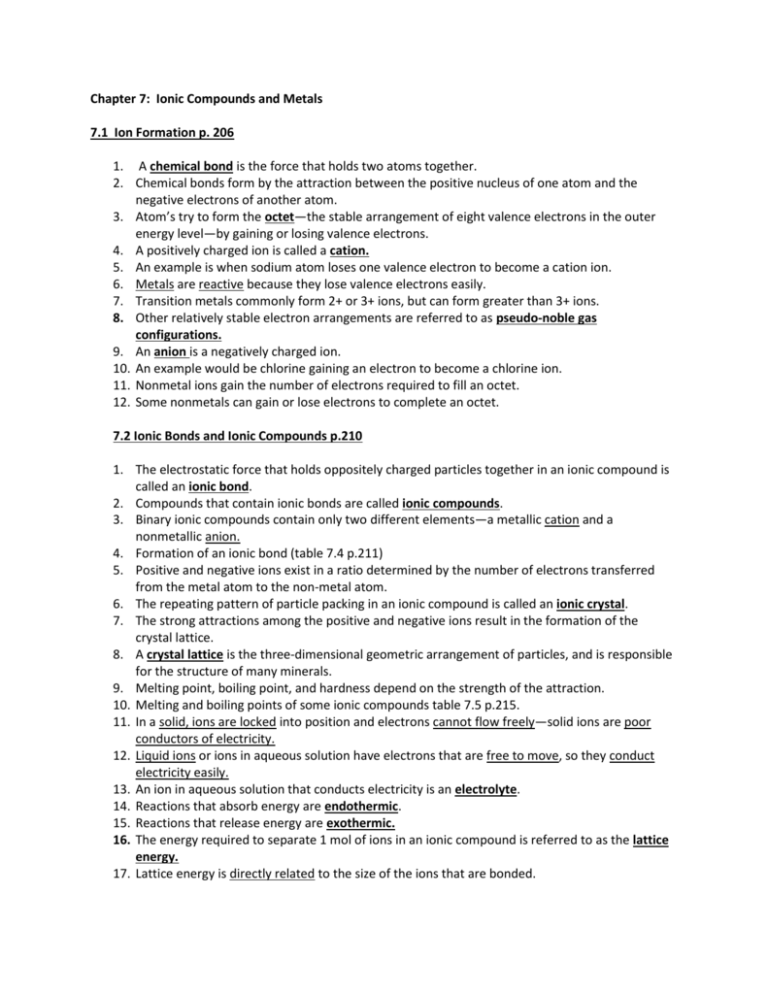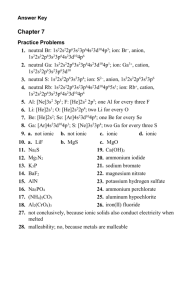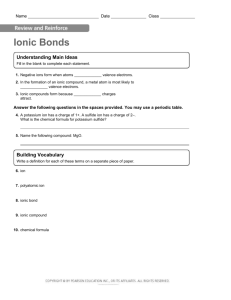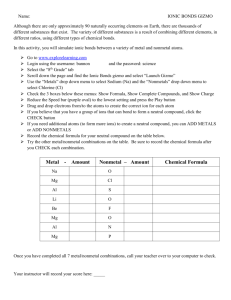Chapter 7: Ionic Compounds and Metals 7.1 Ion Formation p. 206 A
advertisement

Chapter 7: Ionic Compounds and Metals 7.1 Ion Formation p. 206 1. A chemical bond is the force that holds two atoms together. 2. Chemical bonds form by the attraction between the positive nucleus of one atom and the negative electrons of another atom. 3. Atom’s try to form the octet—the stable arrangement of eight valence electrons in the outer energy level—by gaining or losing valence electrons. 4. A positively charged ion is called a cation. 5. An example is when sodium atom loses one valence electron to become a cation ion. 6. Metals are reactive because they lose valence electrons easily. 7. Transition metals commonly form 2+ or 3+ ions, but can form greater than 3+ ions. 8. Other relatively stable electron arrangements are referred to as pseudo-noble gas configurations. 9. An anion is a negatively charged ion. 10. An example would be chlorine gaining an electron to become a chlorine ion. 11. Nonmetal ions gain the number of electrons required to fill an octet. 12. Some nonmetals can gain or lose electrons to complete an octet. 7.2 Ionic Bonds and Ionic Compounds p.210 1. The electrostatic force that holds oppositely charged particles together in an ionic compound is called an ionic bond. 2. Compounds that contain ionic bonds are called ionic compounds. 3. Binary ionic compounds contain only two different elements—a metallic cation and a nonmetallic anion. 4. Formation of an ionic bond (table 7.4 p.211) 5. Positive and negative ions exist in a ratio determined by the number of electrons transferred from the metal atom to the non-metal atom. 6. The repeating pattern of particle packing in an ionic compound is called an ionic crystal. 7. The strong attractions among the positive and negative ions result in the formation of the crystal lattice. 8. A crystal lattice is the three-dimensional geometric arrangement of particles, and is responsible for the structure of many minerals. 9. Melting point, boiling point, and hardness depend on the strength of the attraction. 10. Melting and boiling points of some ionic compounds table 7.5 p.215. 11. In a solid, ions are locked into position and electrons cannot flow freely—solid ions are poor conductors of electricity. 12. Liquid ions or ions in aqueous solution have electrons that are free to move, so they conduct electricity easily. 13. An ion in aqueous solution that conducts electricity is an electrolyte. 14. Reactions that absorb energy are endothermic. 15. Reactions that release energy are exothermic. 16. The energy required to separate 1 mol of ions in an ionic compound is referred to as the lattice energy. 17. Lattice energy is directly related to the size of the ions that are bonded. 18. Smaller ions form compounds with more closely spaced ionic charges, and require more energy to separate. 19. Electrostatic force of attraction is inversely related to the distance to the distance between the opposite charges. 20. The smaller the ion, the greater the attraction. 21. The value of lattice energy is also affected by the charge of the ion. 7.3 Names and Formulas for Ionic Compounds p.218 1. 2. 3. 4. 5. 6. 7. 8. 9. 10. 11. 12. 13. A formula unit represents the simplest ratio of the ions involved. Monatomic ions are one-atom ions. Table 7.7 common monatomic ion. P.219 Oxidation number, or oxidation state, is the charge of a monatomic ion. The symbol for the cation is always written first, followed by the symbol of the anion. Subscripts represent the number of ions of each element in an ionic compound. The total charge must equal zero in an ionic compound. Polyatomic ions are ions made up of more than one atom. Never change subscripts of polyatomic ions, place in parentheses and write the appropriate subscript outside the parentheses. Formulas for polyatomic ions, table 7.9 page 221 An oxyanion is a polyatomic ion composed of an element (usually a non-metal), bonded to one or more oxygen atoms. Oxyanion Naming Conventions for Sulfur and Nitrogen: Table 7.10 p.222 a. Identify the ion with the greatest number of oxygen atoms. This ion is named using the root of the nonmetal and the suffix –ate. b. Identify the ion with fewer oxygen atoms. This ion is named using the root of the nonmetal and the suffix –ite. c. Examples: NO3- (nitrate) and NO2- (nitrite) d. Examples: SO42- (sulfate) and SO32- (sulfite) Oxyanion Naming Conventions for Chlorine: Table 7.11 a. The oxyanion with the greatest number of oxygen atoms is named using the prefix per-, the root of the nonmetal, and the suffix –ate. b. The oxyanion with one fewer oxygen atom is named using the root of the nonmetal and the suffix –ate. c. The oxyanion with two fewer oxygen atoms is named using the root of the nonmetal and the suffix –ite. d. The oxyanion with three fewer oxygen atoms is named using the prefix hypo-, the root of the nonmetal, and the suffix –ite. e. Examples: i. ClO4- perchlorate ii. ClO3- chlorate iii. ClO2- chlorite iv. ClOhypochlorite 14. Chemical nomenclature is a systematic way of naming compounds. a. Name the cation followed by the anion. b. For monatomic cations, use the element name. c. For monatomic anions, use the root element name. d. For monatomic anions, use the root element name and the suffix –ide. e. To distinguish between different oxidation states of the same element, the oxidation state is written in parentheses after the name of the cation. f. When the compound contains a polyatomic ion, name the cation followed by the name of the polyatomic ion. 7.4 Metallic Bonds and the Properties of Metals. P. 225 1. Metals are not ionic but share several properties with ionic compounds. 2. Metals also form lattices in the solid state, where 8 to 12 other atoms closely surround each metal atom. 3. Within the crowded lattice, the outer energy levels of metal atoms overlap. 4. The electron sea model proposes that all metal atoms in a metallic solid contribute their valence electrons to form a “sea” of electrons. 5. The electrons are free to move around and are referred to as delocalized electrons, forming a metallic cation. 6. A metallic bond is the attraction of an metallic cation for delocalized electrons. 7. Boiling points are much more extreme than melting points because of the energy required to separate atoms from the groups of cations and electrons. 8. Metals are malleable because they can be hammered into sheets. 9. Metals are ductile because they can be drawn into wires. 10. Mobile electrons around cations make metals good conductors of electricity and heat. 11. As the number of delocalized electrons increases, so does hardness and strength. 12. An alloy is a mixture of elements that has metallic properties. 13. The properties of alloys differ from the elements they contain. 14. Commercial alloys in table 7.13 228 15. Substitutional alloys are formed when some atoms in the original metallic solid are replaced by other metals of similar atomic structure. 16. Interstitial alloys are formed when small holes in a metallic crystal are filled with smaller atoms.









